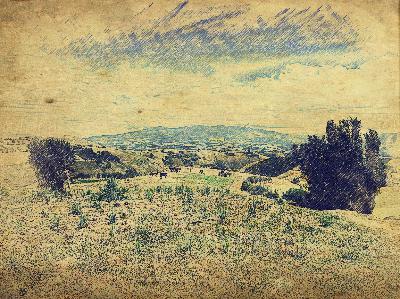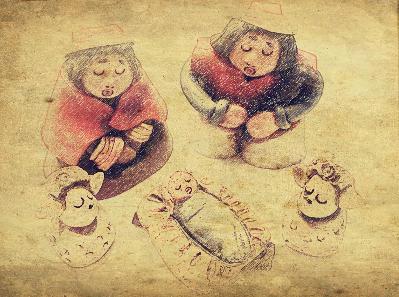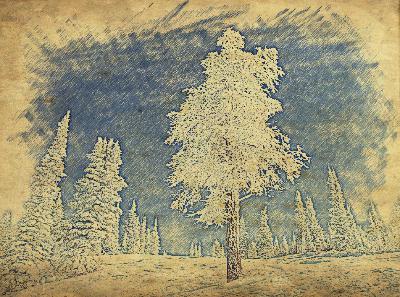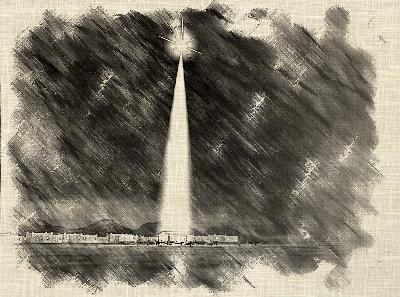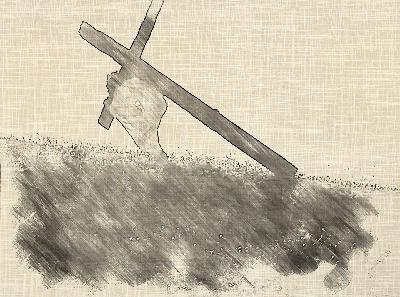Exploring ‘Joy to the World’: Hymn Origins and Meaning
Description
In the hushed corridors of time, where the echoes of prophecy and fulfillment intertwine, we find ourselves drawn to a hymn that has become synonymous with the joyous celebration of Christ’s nativity. “Joy to the World, the Lord is Come!” resonates through the ages, its melody a clarion call to the faithful and a beacon of hope to the seeking. Yet, as we peel back the layers of this beloved composition, we uncover a profound truth that may challenge our preconceptions and deepen our appreciation for the mysterious ways in which God weaves His tapestry of revelation.
Isaac Watts, that prolific hymn writer of the 18th century, penned these immortal words not as a Christmas carol, but as a poetic interpretation of the concluding verses of Psalm 98. In this realization, we are confronted with the beautiful irony of divine inspiration – how a meditation on an Old Testament psalm could so perfectly capture the essence of the New Testament’s greatest gift. It is as though the very stones of Scripture cry out, echoing across millennia to proclaim the coming of the Messiah.
Let us pause for a moment and consider the words of Psalm 98:4-9, which served as the wellspring for Watts’ inspiration:
“Make a joyful noise unto the Lord, all the earth: make a loud noise, and rejoice, and sing praise. Sing unto the Lord with the harp; with the harp, and the voice of a psalm. With trumpets and sound of cornet make a joyful noise before the Lord, the King. Let the sea roar, and the fulness thereof; the world, and they that dwell therein. Let the floods clap their hands: let the hills be joyful together before the Lord; for he cometh to judge the earth: with righteousness shall he judge the world, and the people with equity.”
In these verses, we find the seeds of Watts’ hymn, the call for all creation to join in exultant praise at the coming of the Lord. Yet, Watts, in his profound theological insight, saw beyond the immediate context of the psalm to its ultimate fulfillment in Christ. He understood that the judgment spoken of in the psalm was not merely a future event, but a present reality in the person of Jesus – the incarnate Word who came not to condemn the world, but to save it (John 3:17 ).
As we delve deeper into the hymn, we find ourselves standing at the intersection of prophecy and fulfillment, of expectation and realization. The first stanza bursts forth with unbridled exuberance:
“Joy to the world, the Lord is come!
Let earth receive her King!
Let ev’ry heart prepare Him room,
and heav’n and nature sing,
and heav’n and nature sing,
and heav’n, and heav’n and nature sing.”
Here, Watts captures the cosmic significance of Christ’s advent. The Lord’s coming is not merely a historical event, but a reality that reverberates through every fiber of creation. The earth itself is called to “receive her King,” a phrase that echoes the prologue of John’s Gospel: “He came to that which was his own, but his own did not receive him” (John 1:11 ). In this, we are confronted with the paradox of the Incarnation – the Creator entering His creation, the Infinite clothing Himself in finitude.
The call for every heart to “prepare Him room” is a gentle yet urgent rebuke to our own complacency. How often do we, like the innkeeper of Bethlehem, find our hearts too crowded with the cares and concerns of this world to make space for the King of kings? This line invites us to a deep and searching introspection, challenging us to clear out the clutter of our lives and create a sanctuary for the Divine presence.
As we move to the second stanza, we encounter a shift in perspective:
“Joy to the earth, the Savior reigns!
Let men their songs employ,
while fields and floods, rocks, hills, and plains
repeat the sounding joy,
repeat the sounding joy,
repeat, repeat the sounding joy.”
Here, Watts expands on the psalm’s imagery of nature joining in praise. The repetition of “repeat the sounding joy” is not mere poetic device, but a profound theological statement. It speaks to the enduring nature of Christ’s reign, a joy that echoes and re-echoes through creation. In this, we are reminded of Jesus’ words to the Pharisees who sought to silence His disciples: “I tell you, if these were silent, the very stones would cry out” (Luke 19:40 ).
The third stanza takes us into deeper theological waters:
“No more let sins and sorrows grow,
nor thorns infest the ground;
He comes to make His blessings flow
far as the curse is found,
far as the curse is found,
far as, far as the curse is found.”
Here, Watts alludes to the curse pronounced in Genesis 3, where thorns and thistles became emblematic of the fall’s impact on creation. Yet, in Christ’s coming, we see the beginning of the curse’s undoing. The blessings that flow from His advent extend “far as the curse is found,” a powerful image of redemption’s scope. This is not a narrow salvation, but one that encompasses the entirety of the created order, echoing Paul’s words in Romans 8:19-21: “For the creation waits with eager longing for the revealing of the sons of God… in hope that the creation itself will be set free from its bondage to corruption and obtain the freedom of the glory of the children of God.”
The final stanza brings us to the culmination of Watts’ vision:
“He rules the world with truth and grace,
and makes the nations prove
the glories of His righteousness
and wonders of His love,
and wonders of His love,
and wonders, wonders of His love.”
Here, we see Christ not merely as the babe in the manger, but as the sovereign Lord of all creation. His rule is characterized by the perfect balance of truth and grace, a theme that resonates throughout John’s Gospel: “For the law was given through Moses; grace and truth came through Jesus Christ” (John 1:17 ). The nations, in their tumultuous history and diverse cultures, become the canvas upon which the glories of His righteousness and the wonders of His love are displayed.
As we reflect on these profound words, we cannot help but marvel at the weight of Mary’s divine calling. Imagine the young virgin, chosen to bear the very Son of God, pondering these truths in her heart. The angel’s words to her, “He will be great and will be called the Son of the Most High. The Lord God will give him the throne of his father David, and he will reign over Jacob’s descendants forever; his kingdom will never end” (Luke 1:32-33), find their poetic expression in Watts’ hymn.
Mary’s “yes” to God’s call set in motion the fulfillment of prophecies stretching back to the dawn of time. In her womb, she carried the One who would bring joy to the world, the King whom the earth would receive, the Savior whose reign would extend to every corner of creation. Her simple faith and obedience became the conduit through which God’s blessings would flow “far as the curse is found.”
As we sing this beloved hymn during the Christmas season, let us pause to consider its deeper implications. Though not originally intended as a Christmas carol, its inclusion in our holiday celebrations is far from arbitrary. For in the birth of Christ, we see the first fruits of the joy, redemption, and sovereignty that Watts so eloquently describes.
The hymn challenges us to expand our understanding of Christ’s advent beyond the confines of a single day or season. It calls us to recognize that the joy of Christmas is not a fleeting emotion, but a profound reality that should permeate every aspect of our lives. It invites us to see Christ’s birth not as an isolated event, but as the pivotal moment in God’s grand narrative of redemption – a narrative that encompasses all of creation and stretches into eternity.
Moreover, “Joy to the World” reminds us that the coming of Christ is not merely a past event to be commemorated, but a present reality to be lived and a future hope to be anticipated. In singing of Christ’s rule “with truth and grace,” we are called to be agents of that rule in our own spheres of influence. We are challenged to embody the joy, peace, and love that Christ brings, becoming living testimonies to the “wonders of His love.”
As we reflect on Watts’ hymn in light of its original context and its adoption as a Christmas carol, we are drawn into a deeper appreciation of the mystery of God’s revelation. We see how the Holy Spirit has used human creativity and insight to illuminate divine truth in ways that transcend the original intent of the human author. This should humble us and fill us with awe at the intricate ways in which God weaves His message through human history and culture.
In conclusion, “Joy to the World, the Lord is Come!” stands as a testament to the power of inspired poetry to capture and convey profound theological truths. Its journey from a meditation on Psalm 98 to a beloved Christmas hymn mirrors the journey of faith itself – from expectation to realization, from prophecy to fulfillment. As we sing these words, may we be ever mindful of their rich theological content and their call to personal response.
Let us, like Mary, ponder these things in our hearts. Let us prepare room for Christ not just in the manger scenes of our Christmas decorations, but in the very fabric of our daily lives. May we be attuned to the joy that reverberates through creation at His coming, and may we join our voices with the fields and floods, rocks, hills, and plains in repeating the sounding joy.
For indeed, the Lord is come. The King has arrived. And in His coming, we find the source of true and lasting joy – a joy that transcends circumstances, a joy that overcomes sorrow, a joy that points us toward the ultimate fulfillment of all God’s promises. In this se












